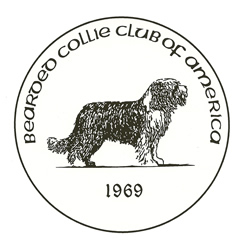© Chris Walkowicz
 At a recent National, our judge penalized trimmed dogs and reminded people trimming is a serious fault in our breed. This prompted a lively discussion on the internet Beardies-List. A review of the serious faults listed in the Bearded Collie Standard seems appropriate. Listed as serious faults are: snipey muzzle, flat or steep croup, height over or under the ideal, an excessively long, silky coat, and a trimmed or sculptured coat.
At a recent National, our judge penalized trimmed dogs and reminded people trimming is a serious fault in our breed. This prompted a lively discussion on the internet Beardies-List. A review of the serious faults listed in the Bearded Collie Standard seems appropriate. Listed as serious faults are: snipey muzzle, flat or steep croup, height over or under the ideal, an excessively long, silky coat, and a trimmed or sculptured coat.
Let’s start with the easiest to recognize: height over or under the ideal. Males should be 21 to 22 inches tall at the withers, with bitches being 20 – 21 inches. The Standard goes on to read, “The express objective of this criterion is to insure that the Bearded Collie remains a medium sized dog.”
Dogs and bitches may mature at slightly over or under the Standard and are usually penalized according to the disparity. Although the Standard sets forth the ideal, minor discrepancies of size are not as important as body proportion. Breeders often accept an inch over or under the ideal, decreasing or increasing to the ideal in the next generation. The medium size allows the Beardie to move swiftly and gather its charges, with sharp turns, screeching halts and shoulder-high leaps. When too much allowance is given, with dogs creeping up to an inch and a half or more towering over the ideal, the whole prospect of maintaining a medium-sized dog becomes impossible.
Snipey muzzle: “…the muzzle is strong and full….” This was a problem we saw more frequently when Beardies were first approved in 1977. The muzzle should be equal in length to the backskull and, on the adult dog, full enough to fill a hand encircling it. The muzzle should not be tapered like a Collie’s or Border Collie’s, but more boxy in shape.
Weak underjaws often hide bad mouths. Although we still have some bad bites (and mouths that seem to move around during the entire life of the dog), they have improved over the years.
Flat or steep croup: “The level back line blends smoothly into the curve of the rump.” The croup, as in many dogs, is angled at about thirty degrees. This allows the dog fluidity of movement, good reach and drive and the agility to perform those startling leaps when they look you in the eye and kiss you on the nose.
Coat: “The dog should be shown as naturally as is consistent with good grooming but the coat must not be trimmed in any way. An excessively long, silky coat or one which has been trimmed in any way must be severely penalized.” When I first wrote The Bearded Collie a dozen years ago, I didn’t even mention trimming in the interpretation of the Standard. Now, sending an on-line seminar to the Judges List, I took two pages to address the subject.
Twenty years ago, most exhibitors stopped at a hygienic trim (in order to live with the dog). As the chase for the purple-and-gold soared, coats were poufed, coiffed and glamorized to become more beauteous and bountiful. Conditioners entered the picture. Brambles, so well known in the Beardie’s mother country, are usually not found in the typical U.S. backyard and, besides, they’d tear the precious coat! These changes meant the hair on the feet sometimes began to look like bedroom slippers. It would be difficult now to find many dogs that haven’t had the feet “neatened,” as the exhibitors prefer to call it. Sculpturing, however, is another matter totally, and most exhibitors also object to it.
Unfortunately, the old give-‘em-an-inch-and-they’ll-take-a-mile syndrome has bitten some of the handlers and owners. It’s not uncommon to see the bottom line evened out, manes thinned, and/or hocks shaped. Occasionally, we even see tails trimmed, ears and beard squared, and side coat “evened” or layered.
Structural faults, i.e., deviations from the ideal height, snipey muzzles and flat or steep croups, are serious. Trimming is but one fault and a cosmetic one at that, but it is, according to our Standard, also a serious fault and should be considered such by judges, exhibitors, handlers and spectators.
This article first appeared in the AKC Gazette’s breed columns in June, 1997.





You must be logged in to post a comment.